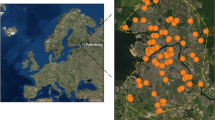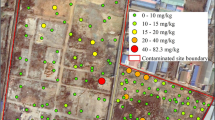Abstract
Contamination by any substance takes place through air, water or soil and causes serious effects on flora and fauna of the regions. Air-transmitted pollutants spread in a faraway place from emission points of the pollutant source via wind (speed and direction as causing factors). Fluoride is one the pollutant generated in aluminium industries which is harmful to human and plants in excess concentration. This study focuses on the use of spatial interpolation methods for assessment of fluoride concentration around aluminium industries. The samples were collected from different test sites in the study area to investigate the fluoride concentration level. The test sites include several locations such as industrial unit, river site, residential and distant villages. Then, the collected samples were used to predict the overall fluoride concentration in the entire study area. The aim of the study was to evaluate the spatial variation and presence of fluoride concentration in the surroundings of the aluminium industries. Geostatistical interpolation modelling was applied to assess the prediction of fluoride contamination for other non-sampling points using the direction and distance method of empirical Bayesian kriging (EBK) modelling. Thus, geospatial modelling was used to predict the contamination of fluoride around the study area to create environmental awareness. In particular, this study assesses the fluoride pollutant concentration which might become dangerous with slowly increasing concentration against its standard concentration, which will severely impact the human health. In overall, EBK can provide valuable information regarding the fluoride concentration on possible level of fluoride in concern to public health.







Similar content being viewed by others
References
ABMC (2013) Hindalco. Available online: http://www.hindalco.com/renukoot. Accessed 29 Dec 2013
ATSDR (2003) Fluorides, hydrogen, fluoride, and fluorine, U.S. Department of health and human services public health service agency for toxic substances and disease registry Atlanta, GA, USA. Available online: http://www.atsdr.cdc.gov/toxguides/toxguide-11.pdf. Accessed 13 Jan 2013
Chang CW (2012) Fluoride. In: Mudd JB, Kozlowosky TT (eds) Responses of plants to air pollution. Academic press, New York, pp 57–96
Cheremisinoff PN (1993) Indoor/in-plant quality. In: Cheremisinoff PN (ed) Air pollution control and design for industry. CRC Press, New York, pp 557–565
Drury JS, Ensminger JT, Hammons AS, Holleman JW, Lewis EB, Preston EL, Shriner CR, Towill LE (1980) Reviews of the environmental effects of pollutants. IX. Fluoride. No. ORNL/EIS-85; EPA-600/1-78-050. Oak Ridge National Lab., TN
Edmunds WM, Smedley PL (2005) Fluoride in natural waters. In: Alloway BJ, Selinus O (eds) Essentials of medical geology. Elsevier, London, pp 301–329
EPA (1976) Fluorine, its compounds, and air pollution: bibliography with abstracts, Air Pollution Technical Information Center, Environmental Protection Agency, Publication number- EPA-450-/1-76-003 Washington, USA, Dec 1976, pp 892
ESRI (2011) An overview of the interpolation tools, ArcGIS Desktop Help, Last modified September 7, 2011, Environmental Systems Research Institute, Inc. Available online: http://webhelp.esri.com/arcgisdesktop/9.3/index.cfm?TopicName=An_overview_of_the_Interpolation_tools. Accessed 12 Oct 2013
Fawel J, Bailey K, Chilton J, Dahi E, Fewtrell L, Magara Y (2006) Fluoride in drinking-water. IWA Publishing, London
Frant MS, Ross JW (1966) Electrode for sensing fluoride ion activity in solution. Science 154:1553–1554
Freeman MJ, Cheremisinoff PN, Ziminski RW (1993) Electrostatics and electrostatic precipitation. In: Cheremisinoff PN (ed) Air pollution control and design for industry. CRC Press, New York, pp 157–188
Gago C, Romar A, Fernández-Marcos ML, Álvarez E (2014) Fluoride sorption and desorption on soils located in the surroundings of an aluminium smelter in Galicia (NW Spain). Environ Earth Sci 72(10):4105–4114
Gribov A, Krivoruchko K (2012) New flexible non-parametric data transformation for trans-gaussian kriging. In: Geostatistics Oslo 2012, quantitative geology and geostatistics. Springer, Netherlands, pp 51–65
Hodge HC, Smith FA (1977) Occupational fluoride exposure. J Occup Med 19(1):12–39
IPCS (2010) Environmental health criteria 227 fluorides. Effects of ingested fluoride,Geneva. National Academy Press, Washington DC
Jackson P, Harvey P, Young W (2002) Chemistry and bioavailability aspects of fluoride in drinking water. WRc-NSF, Marlow
Jacobson JS, Weinstein LH (1977) Sampling and analysis of fluoride: methods for ambient air, plant and animal tissues, water, soil and foods. J Occup Med 19(1):79–87
Krivoruchko K (2011) Spatial statistical data analysis for GIS users. Esri Press, Redlands, p 928
Kumar P, Rani M (2011) Impact of fluoride on flora in and around Hindalco Industries Ltd., Renukoot (India). J Appl Environ Biol Sci 5:81–83
Leyva-Ramos R, Medellin-Castillo NA, Jacobo-Azuara A, Mendoza-Barron J, Landin-Rodriguez LE, Martinez-Rosales JM, Aragon-Piña A (2008) Fluoride removal from water solution by adsorption on activated alumina prepared from pseudo-boehmite. J Environ Eng Manage 18(5):301–309
Martin AE, Jones CM (1971) Some medical considerations regarding atmospheric fluorides. HSMHA Health Rep 86:752–758
NAS (1971) Fluorides, committee on biological effects of atmospheric pollutants. National Academy of Sciences, Washington DC, p 295
Nesterenko V (2002) Radiation monitoring of the inhabitants and their foodstuffs in the Chernobyl zone of Belarus. Inform Bull 22. (in Russian)
Ozsvath DL (2009) Fluoride and environmental health: a review. Rev Environ Sci Biotechnol 8(1):59–79. doi:10.1007/s11157-008-9136-9
Pandey PC, Kumar P, Rani M, Katiyar S, Tomar V (2014) Fluoride-induced impact of aluminium industrial power plant on plants and human inhabiting areas. Geofizika 31(2):151–168. doi:10.15233/gfz.2014.31.8
Singh A, Jolly SS, Bansal BC, Mathur CC (1963) Endemic fluorosis. Epidemiological, clinical and biochemical study of chronic fluoride intoxication in Punjab. Medicine 42(3):229–246
Singh SK, Srivastava PK, Pandey AC (2013a) Fluoride contamination mapping of groundwater in Northern India integrated with geochemical indicators and GIS. Water Sci Technol Water Supply 13(6):1513–1523
Singh SK, Srivastava PK, Pandey AC, Gautam SK (2013b) Integrated assessment of groundwater influenced by a confluence river system: concurrence with remote sensing and geochemical modelling. Water Resour Manage 27(12):4291–4313
WHO (2000) Fluorides. In: Air quality guidelines, Chapter 6.5, WHO Regional Office for Europe: Copenhagen, Denmark. Available Online: http://www.euro.who.int/__data/assets/pdf_file/0018/123075/AQG2ndEd_6_5Fluorides.PDF
WHO (2011) Guidelines for drinking-water quality, 4th edn. WHO, Geneva. Available online: http://whqlibdoc.who.int/publications/2011/9789241548151_eng.pdf?ua=1
Yablokov AV, Nesterenko VB, Nesterenko AV (2010) Chernobyl: consequences of the catastrophe for people and the environment. Wiley-Blackwell, New York
Young SM, Pitawala A, Ishiga H (2011) Factors controlling fluoride contents of groundwater in north-central and northwestern Sri Lanka. Environ Earth Sci 63:1333–1342
Acknowledgments
Authors were grateful to Environmental cell team, Hindalco industries, Renukoot, UP, India for providing the assistance and help to understand the process of aluminium manufacturing from alumina. Authors are thankful to Environmental cell staffs for providing all necessary support during the field sampling and lab analysis. Thanks are also due to Dr. A. K Susheela for providing the valuable suggestion and guidance.
Author information
Authors and Affiliations
Corresponding author
Additional information
This article is part of a Topical Collection in Environmental Earth Sciences on “Environmental Problems and Solutions in India”, guest edited by Tanu Jindal.
Rights and permissions
About this article
Cite this article
Pandey, P.C., Kumar, P., Tomar, V. et al. Modelling spatial variation of fluoride pollutant using geospatial approach in the surrounding environment of an aluminium industries. Environ Earth Sci 74, 7801–7812 (2015). https://doi.org/10.1007/s12665-015-4563-8
Received:
Accepted:
Published:
Issue Date:
DOI: https://doi.org/10.1007/s12665-015-4563-8




